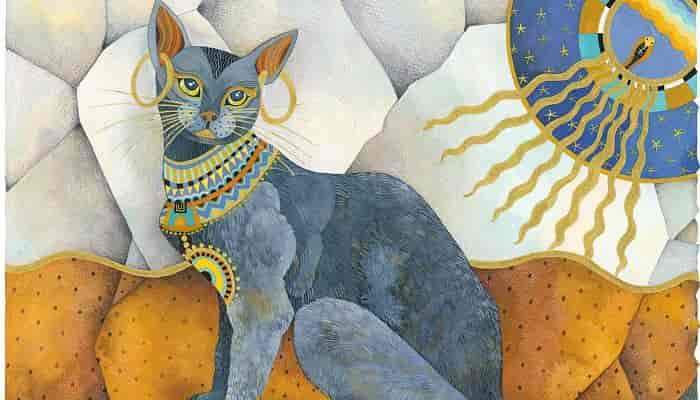The Ancient Egypt is one of the most fascinating cultures that ever populated the earth and despite all the research and studies done over the past decades there is still a lot of mystery surrounding their lifestyle, traditions and believes.
One of the main characteristics that all researches agree on is that Egyptians had a fascination for animals and many of them were used to explain incomprehensible phenomes or were associated with gods. It is not illogical if we think about how life was in that time and all the dangers humans were constantly facing. Usually the animals with stronger religious and spiritual meaning were the closest to them, the simpler that they could see daily. In this case the Egyptians develop a special devotion for cats above any other animal. The reason why is still uncertain and remains one of the many mysteries about Ancient Egypt.
What we know for sure is that Egyptians had a great admiration for felines as they were one of the most venerated species. The Egyptians were the first civilization to domesticated them and were treated like another member of the household. Despite being used as a protector of the homes some studies suggest that the Egyptians believed cats were related to divinities. That’s why the received a privileged treatment from the community.
Before reading please consider that this is a general recompilation of interesting facts, some of them might change slightly depending on what era are we referring to. Nonetheless, all these statements were true at some point during their ancient history.
This is a list of 10 curiosities about cats in the ancient Egypt you might not know…
1. The goddess Bastet was represented with the head of a cat.

The goddess Bastet was usually represented with the head of a feline and a golden earing. It was believed that one of the ways people could offend the goddess was to harm one of her cats. When she was really angry, she could transform into a fearful lion thirsty for blood and the only way to calm her down was through offering beer. She represented beauty, joy, love, happiness and was the protector of humans.
Bastet was extremely popular during the second dynasty (2890-2670 BC) and had her cult center in the city of Bubastis. It is believed that a temple in her honor was built in the city and mummified cat were buried inside as an offering to the goddess.
2. The Egyptian word for cat was an onomatopoeia that sounded like an actual cat.

According to experts the word cat in the ancient Egypt was pronounced like “miu” or “meow”. This refers to the sound cats make when they meow.
It is particularly curious that despite their great admiration they only had this one word to refer to cats. It was a general word, which means they didn’t differentiate between species or any other categorization. Moreover, in the Egyptian alphabet there is a jerogr to represent exclusively the cats which is obviously the silhouette of a cat.
3. Killing a cat or being involved in the death of one was punished by death.

Killing a cat was considered a major capital therefore the punishment was to sufferer the same result as the victim, death. Depending on the period of time if the death was produced by accident the punishment was either the same or could be replace by the payment of a fine. As Herodotus repots, Egyptians caught in a burning building would save the cast first, before trying to save themselves, another person or attempting to put out the fire. Some experts suggest that not even the emperor could forgive somebody that had committed this crime. There is a popular story amongst amateurs that explains that not even Pharaoh Ptolemy XII Auletes, father of the legendary Cleopatra, couldn’t stop the death of a Roman solider who had killed a cat by accident. So, the poor solider, unaware of the severity of the crime he had committed, was sentenced to death.
Nonetheless, some theories suggest that during certain periods cats were sacrificed and mummified in the city of Bubastis as an offering to the goddess Bastet, of which we have spoken in the first curiosity. Other theories also hint that cats could be sacrificed in order to be buried next to his owner so that the cat could accompany him in his journey to the other side. These speculations are interesting because it means that depending on the period there could be exceptions to this law.
4. The death of the family cat was a tragedy.

The cat was considered to be another member of the family, that is why they receive the same care as the rest of its members, especially after death. The richer families mummified their cats with jewelry, once it has passed away. Some owners even buried themselves with their cat. When the family cat died the whole family participated in the grieving that involved shaving the eyebrows as a symbol of the pain and sorrow. However, not all cats received treatment. As today, only those that came from a wealthy family would enjoy such a treatment.
5. They had cat cemeteries
The ancient Egyptians had a wide range of pets, including cats, dogs, hippos, falcons among many others. As we have mentioned household pets were mummified and buried usually with their owners. But animals were also mummified in a massive scale. This gigantic cemetery was located in Berenike, a port-town on the Red coast and it is estimated to be nearly 2.000 years old. It belongs to the pre-dynastic era, when the Roman Empire controlled the region. 100 complete animal skeletons were found, including 86 cats, 9 dogs and 2 monkeys. Though this wasn’t the first discovery of mummified ancient pets, however it emphasizes the great lengths Egyptians and Romans went to care for these creatures.
6. It was forbidden to smuggle cats out of the country
Exporting cats out of the country was strictly prohibited by law. There was a specific branch of the government whose task was to deal with this problem. Government agents were sent to other lands to find the cats that had been smuggled out and returned them back. Nonetheless, Phoenician and Greek merchants and later on the Roma legions exported cats illegally to Europe.
7. The Egyptian cats weren’t like our cats.

Like any other domesticated species wild cats had a different constitution that evolve and changed when they started living with humans. As we mentioned previously the Egyptians only had one word to refer to cats because they didn’t differentiate between the different species. Nonetheless, researchers have been able to identify three different kinds of cats from the mummies found in various locations. The first species is called Felis lybica commonly known as African wildcat. This was the most common breed and experts are completely sure that it was domesticated.
The second breed that can be found was the Felis chaus also known as the jungle cat. Although it is likely that this one was also domesticated there aren’t enough evidences. Finally, we can find the Felis serval or serval. This wasn’t a common breed and probably wasn’t autochthonous, but they were imported from Nubia in the south of Egypt. Nowadays this region belongs to the country of Sudan.
8. Cats were commonly used as guardians and as hunters
Cats were a symbol of protection. Is a well-known fact that they are extraordinary haunters. The Egyptians used to have them in their homes where cats would haunt rats, maces, scorpions and snakes. It is believed that this is how they were domesticated. In exchange from keeping the undesirable little animals outside the home and protect the family members (just like the goddess Bastet did) cats were offered food, a home and a safe place from its depredators.
Moreover, other studies also suggest that cats were used to haunt little birds. The owner or in this case the haunter threw a wooden tool, that resembled a boomerang, to kill the bird. The cat was in charge of picking the pray and bringing it back to the owner.
9. The Egyptians lost the Battle of Pelusium because of its fascination for the cats

In 525 BC during the Battle of Pelusium the Persian King Cambyses II, aware of Egyptian culture, had the image of Bastet painted on his soldiers shields and commanded his armies to attached cats and other adored animals like dogs, sheep and ibises in their shields. The Egyptian army seeing their beloved goddess on the enemies shields and afraid that they might injure the sacred animals didn’t attack and surrendered their positions. Many were massacred on the field and those that weren’t killed fled to the city of Memphis. Memphis was besieged and fell shortly after. Pharaoh Psametik II was captured and executed. Thus ended the sovereignty of Egypt and the territory was annexed to Persia until the arrival of Alexander the Great, many years after .
It is said that the Persians would have won regardless of the tactic used since King Cambyses II had far more experience than young Pharaoh Psametik II, who had just been crowned. Nonetheless, the battle was won through this unusual strategy to use animals as hostage.
10. The most popular Egyptian found sculpture is the Gayer-Anderson cat

Hundreds of cat’s representations have been discovered over the past years. However, the most famous and better-preserve it the Gayer-Anderson Cat Statue that has enchanted many writers, artists and sculptors with its beauty and charm. As Marcel Marée, curator for the Egyptian sculpture gallery at the British Museum, said “This cat figure is among the very finest surviving from ancient Egypt, and justly regarded as one of the British Museum’s greatest masterpieces.” It is a bronze statue representing the goddess Bastet in her cat form adorated with golden earrings. It is estimated to be from around the 600 BC. Therefore, it probably belonged to the Late Period (around 664-322 BC). It’s named after Major Robert Grenville Gayer-Anderson, who donated the statue to the British museum in the 1939. Previously it was showcased in his house, now transformed into the Grayer-Anderson Museum.
Although, there aren’t any conclusive evidences experts suggest that it comes from a temple. It was customary to have bronze figures of gods, varying in sizes and forms, inside the temples throughout Egypt as a sign of power, admiration and respect. Another function of the statues was to help believers communicate with the gods. Only a king or someone very wealthy could afford buying a piece like this because it is adorned with precious metals.
The sculpture is wearing a silver protective pectoral that invoked protection and healing, golden earrings and nose ring, representing the goddess Bastet and has a scarab beetle drawn on the cat’s heat and chest that symbolizes rebirth .
If you wish to learn more about the sculpture, it can be visited in the British Museum in London. You will find it in the Oriental Art collection, room 4. If not we strongly encourage you to have a look at the British Museum’s website were there is 3D model and a detailed scientific analysis of the piece.






